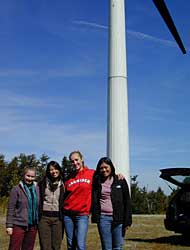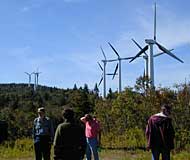 |
Smith
Team Eyes the Future of Energy Production
As Smith College and the
rest of the country search for alternative energy sources,
a team of students, faculty and staff members traveled
to Vermont recently to tour a wind farm. Power generated
by wind is becoming an increasingly viable option and,
as a clean, renewable source of energy, is of particular
interest to Smith students.
On a beautiful autumn Saturday,
Sept. 20, Smith students, accompanied by Denise McKay, assistant
professor of engineering, and the college’s
Green Team, toured Green Mountain Power’s wind farm
in Searsburg, Vt. When it came online, the Searsburg facility
was the largest in New England.

Smith Students pose near
a power-generating windmill at Green Mountain Power wind
farm. |
On the ride to Searsburg,
Professor McKay, whose interests center on the production
of renewable energies, provided context for power generation;
and on the return trip, she spoke with students about what’s
entailed in graduate studies and various types of engineering
related to environmental issues.
The array of wind turbines at Green Mountain Power sits atop
a 2,500-foot ridgeline on 35 acres of privately owned land
abutting national forest property. Tour guides explained
the lengthy collaborative processes required to develop the
facility, as well as the engineering involved in construction
and computer monitoring of the huge turbines and steel towers
that support them.
The facility’s six-megawatt output produces emission-free
renewable energy for about 1,600 Vermont households.
Equally important are the data on differences in siting and
maintaining wind turbines in the unforgiving New England
climate. Although Green Mountain Power began looking for
wind power sites in the 1970s, New England has fewer suitable
locations than some other parts of the country. Siting requires
good wind speeds, access to nearby roads for materials transport,
nearby high-voltage access, and the absence of rare plants,
archeological sites, wetlands, and significant mammal and
bird breeding areas.
The Searsburg site finally went online in 1997, but not before
some parts had to be replaced because of weather-related
corrosion that is seldom a problem in California, for example,
or open plains areas. Unlike the blades in those sunnier
areas, Vermont’s turbine blades are black to absorb
heat and help remove rime ice that is common in winter.

Giant windmills jut into the sky near Searsburg, Vt. |
Each of the 11 Zond Z-40FS turbines,
and its supporting structure, sits on three feet of concrete
below ground and two feet of rock covering the foundation. The hub that holds
the turbine’s blades sits 132 feet above ground, connected
to a “nacelle” that is larger than a school bus
and holds the control machinery.
The day was bright and sunny, but not very windy. The blades
made a low chuffing sound as they turned in a 132-foot-diameter
circle. These turbines begin to generate power at winds of
10 mph. As the motors repositioned the blades to catch
the light wind, visitors could see the adjustments register
on one tower’s computer monitor, which had been opened
for the group.
Walt, a retired physics teacher, engaged visitors in a clear
explanation of the turbines’ operation and invited
Smith student Marice Uy ’09 to share her experience
as an intern at General Electric’s wind turbine division.
Newer technologies and taller towers (256 feet high) now
enable turbines to generate more power per tower than those
at Green Mountain Power, at wind speeds as low as 6-8 mph.
A future trip to a new utility-scale wind power project in
New Hampshire is in the planning stages.
|
 |























